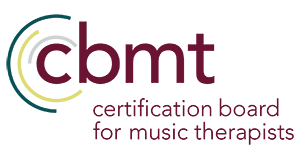CBMT and AMTA: Serving Different Purposes for One Shared Goal
Music therapists are fortunate to have two key organizations dedicated to supporting them and enhancing the services they provide: The Certification Board for Music Therapists (CBMT) and the American Music Therapy Association (AMTA). Although the two groups collaborate in several ways, they have different purposes and missions that set them apart – and for the benefit of the music therapy field, it’s important for both organizations to grow and thrive.
As the only certifying board in music therapy, the CBMT focuses on measuring professional competence, awarding the Music Therapist Board Certified (MT-BC) credential to those who meet stringent certification requirements. The CBMT establishes and maintains these requirements to protect the public by ensuring safe, effective music therapy services. Through its accreditation by the National Commission for Certifying Agencies (NCCA), the CBMT strives for the highest possible standards in its national examination and recertification programs, designed to reflect the most updated knowledge and competence in the field.
AMTA serves as the primary organization for educating the public, establishing education and training standards for music therapists, publishing and disseminating music therapy research, providing resources for ongoing continuing education of music therapists, and working to ensure those who need music therapy get quality services. It focuses on the advancement of clinical practice, research and ethical standards in the music therapy profession. Through its mission of promoting awareness of the benefits of music therapy, AMTA aims to improve the quality of services and increase access to those services in a rapidly changing world.
Together, the CBMT and AMTA have created The Scope of Music Therapy Practice, which defines the practice of music therapy; lists requirements for education and certification; and details the separate (but often complementary) roles of the two groups in developing and maintaining professional music therapists and evidence-based practices. In addition, the CBMT and AMTA work collaboratively on regulatory affairs, legislative issues and research, including a core team that strategizes for state recognition of music therapy and the MT-BC credential.
Sometimes questions may come up as to why it’s necessary to support both organizations. With a distinction of missions between certifying the competent practitioner (CBMT) and promoting the benefits of music therapy to increase awareness and access (AMTA), these groups clearly have different primary focuses – but they do have the same end goals to benefit music therapists, advance the profession, and ensure high-quality services for the public. Maintaining your certification (CBMT) and active membership in the professional organization (AMTA) strengthens the overall health of the music therapy profession. We will all benefit from keeping both CBMT and AMTA strong, and it’s important for you to help by maintaining your MT-BC credential with CBMT and consistently renewing your membership in AMTA each year.



